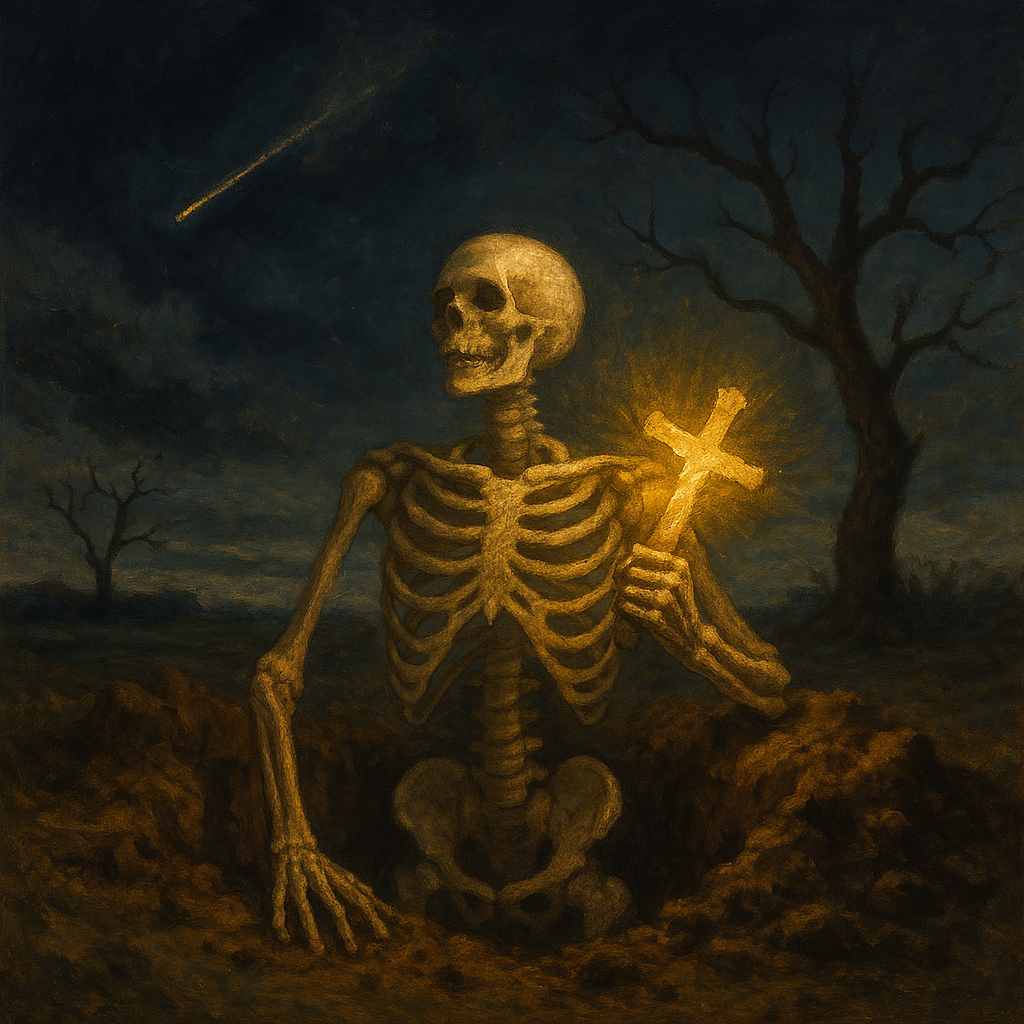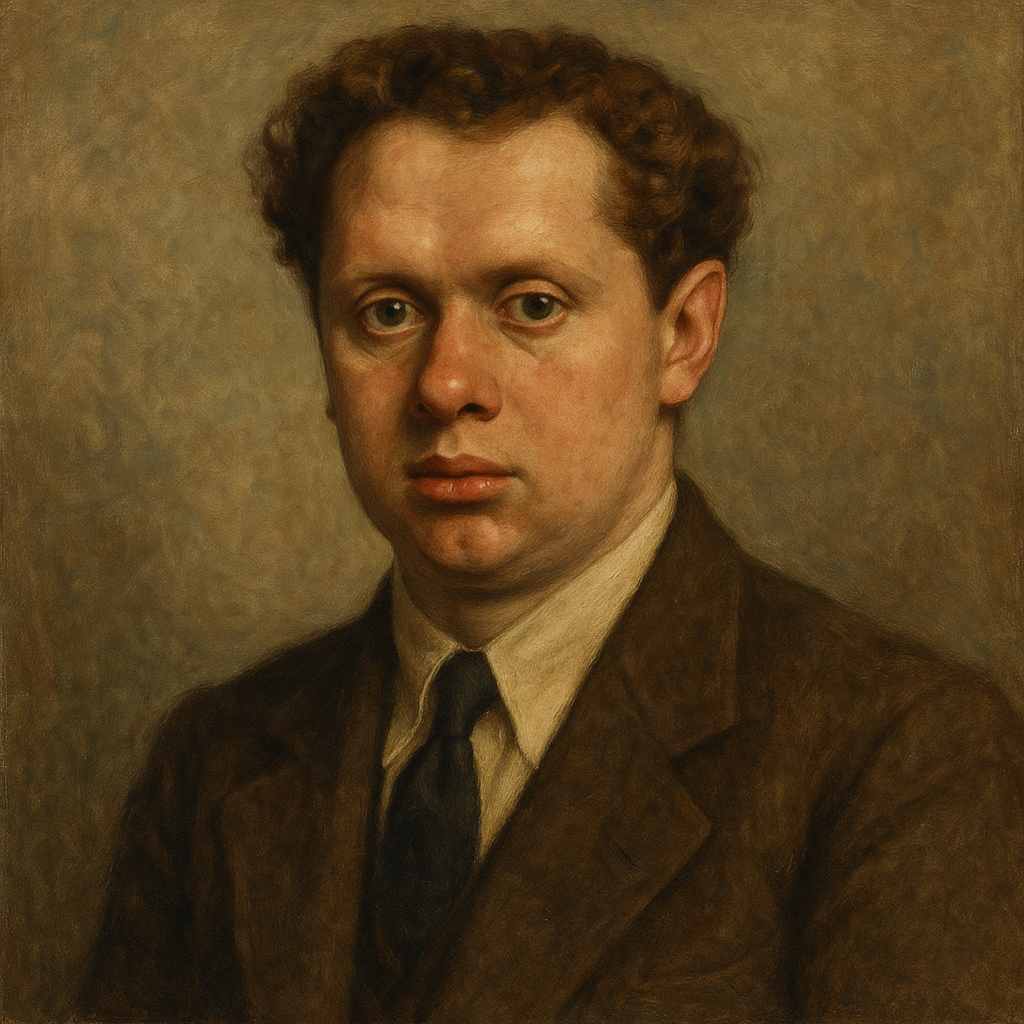No man believes
Dylan Thomas
1914 to 1953

No man believes who, when a star falls shot,
Cries not aloud blind as a bat,
Cries not in terror when a bird is drawn
Into the quicksand feathers down,
Who does not make a wound in faith
When any light goes out, and life is death.
No man believes who cries not, God is not,
Who feels not coldness in the heat,
In the breasted summer longs not for spring,
No breasted girl, no man who, young
And green, sneers not at the old sky.
No man believes who does not wonder why.
Believe and be saved. No man believes
Who curses not what makes and saves,
No man upon this cyst of earth
Believes who does not lance his faith,
No man, no man, no man.
And this is true, no man can live
Who does not bury God in a deep grave
And then raise up the skeleton again,
No man who does not break and make,
Who in the bones finds not new faith,
Lends not flesh to ribs and neck,
Who does not break and make his final faith.
Dylan Thomas's No man believes
Dylan Thomas’s “No Man Believes” is a compact yet thematically dense poem that grapples with existential doubt, faith, and the paradoxical nature of belief. Written in Thomas’s characteristically intense and rhythmic style, the poem interrogates the necessity of struggle in the act of belief, suggesting that true faith is not passive acceptance but an active, often painful engagement with doubt. Through vivid imagery, repetition, and a tone that oscillates between despair and defiance, Thomas crafts a meditation on the human condition—one that resonates with both theological and existential implications.
This essay will explore the poem’s historical and cultural context, its use of literary devices, its central themes, and its emotional impact. Additionally, we will consider how Thomas’s personal struggles with religion and mortality inform the poem, as well as how it aligns with broader philosophical and poetic traditions.
Historical and Cultural Context
Dylan Thomas (1914–1953) emerged as a major poetic voice in the mid-20th century, a period marked by the aftermath of two World Wars, the rise of existential philosophy, and widespread disillusionment with traditional religious structures. Thomas’s work often reflects a tension between Romantic lyricism and modernist fragmentation, blending lush imagery with existential angst.
“No Man Believes” can be situated within the broader discourse of post-war existentialism, where thinkers like Jean-Paul Sartre and Albert Camus questioned the meaning of faith in a seemingly indifferent universe. Thomas, however, approaches these questions not through abstract philosophy but through visceral, almost primal language. The poem’s insistence that belief requires suffering and doubt aligns with Søren Kierkegaard’s notion of the "leap of faith"—the idea that true belief necessitates an embrace of uncertainty rather than its elimination.
Moreover, Thomas’s Welsh heritage, with its strong Nonconformist Christian traditions, informs his preoccupation with sin, redemption, and the divine. Yet his vision is far from orthodox; instead, it is fraught with paradox, suggesting that God must be "buried" and "raised again" in a personal, almost blasphemous ritual of faith.
Literary Devices and Structure
Thomas employs several key literary devices to reinforce the poem’s themes of doubt and belief:
1. Repetition and Anaphora
The poem’s relentless repetition of “No man believes” creates a liturgical quality, echoing both religious incantation and existential lament. This refrain-like structure suggests that belief is not a singular event but a cyclical process of destruction and renewal. The insistent repetition of “no man” also universalizes the poem’s claims, implying that doubt is an inescapable aspect of human existence.
2. Vivid and Violent Imagery
Thomas’s imagery is stark and often unsettling:
-
“a star falls shot”—cosmic destruction mirroring personal crisis.
-
“blind as a bat”—evoking both physical and spiritual blindness.
-
“lance his faith”—a surgical or violent act, suggesting belief must be wounded to be real.
-
“bury God in a deep grave / And then raise up the skeleton again”—a grotesque parody of Christ’s resurrection, underscoring the necessity of doubt in faith.
These images convey the brutality inherent in belief, framing it not as comfort but as a struggle against meaninglessness.
3. Paradox and Oxymoron
The poem thrives on contradiction:
-
“feels not coldness in the heat”
-
“longs not for spring” in summer
-
“break and make his final faith”
These paradoxes reinforce the idea that belief is not static but dynamic, requiring the believer to hold opposing truths in tension.
4. Biblical Allusion
The phrase “Believe and be saved” echoes Christian doctrine, yet Thomas subverts it by suggesting that salvation is impossible without doubt. The image of burying and resurrecting God mirrors Christ’s death and resurrection but frames it as a personal, almost heretical act.
Themes
1. The Necessity of Doubt in Faith
The central argument of the poem is that genuine belief cannot exist without moments of profound doubt. The speaker insists that one must “curse what makes and saves”—that is, reject God in order to truly find Him. This aligns with the mystical tradition of the via negativa, where God is understood through negation rather than affirmation.
2. The Cyclical Nature of Belief
Faith, in Thomas’s vision, is not linear but cyclical. The lines “No man can live / Who does not bury God in a deep grave / And then raise up the skeleton again” suggest that belief must be destroyed and reconstructed repeatedly. This mirrors Thomas’s own vacillations between religious yearning and atheistic despair.
3. The Violence of Existence
The poem is filled with violent imagery—falling stars, quicksand, lancing faith—implying that existence itself is a kind of wound. To believe is not to escape suffering but to engage with it fully.
4. The Search for Meaning in a Silent Cosmos
The final lines—“No man who does not break and make, / Who in the bones finds not new faith”—suggest that meaning is not given but created. This aligns with existentialist thought, where the individual must forge their own purpose in an indifferent universe.
Emotional Impact
The poem’s emotional power lies in its raw, almost desperate tone. Thomas does not offer easy answers; instead, he forces the reader to confront the agony of belief. The repetition of “no man” creates a sense of inevitability, as if doubt is an inescapable human condition. Yet there is also a defiant energy in the poem—a refusal to accept passive faith. The final image of rebuilding faith from bones suggests resilience, even in the face of despair.
Comparative and Biographical Perspectives
Comparison to Other Works
Thomas’s poem shares thematic ground with Gerard Manley Hopkins’ “Carrion Comfort” (which also explores faith through struggle) and T.S. Eliot’s “The Waste Land” (with its fragmented search for meaning). However, Thomas’s approach is more visceral than Eliot’s intellectualism, more personal than Hopkins’ theological rigor.
Biographical Insights
Thomas’s own life was marked by religious ambivalence, alcoholism, and a fascination with death. His father, an atheist, and his mother, a devout Christian, represented the dual forces that shaped his worldview. “No Man Believes” reflects this tension—embracing doubt not as the enemy of faith but as its crucible.
Conclusion
“No Man Believes” is a profound meditation on the nature of faith, doubt, and human resilience. Through its incantatory repetitions, violent imagery, and paradoxical logic, Thomas constructs a vision of belief that is neither comforting nor simple. Instead, he presents faith as a dynamic, painful, and ultimately redemptive struggle—one that requires the believer to “break and make” their own meaning.
In an age of existential uncertainty, Thomas’s poem remains strikingly relevant, speaking to anyone who has wrestled with doubt and emerged, not with easy answers, but with a deeper, harder-won understanding of what it means to believe.
This text was generated by AI and is for reference only. Learn more
Want to join the discussion? Reopen or create a unique username to comment. No personal details required!



Comments
No comments yet. Be the first to comment!